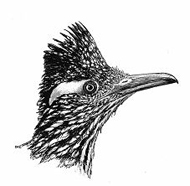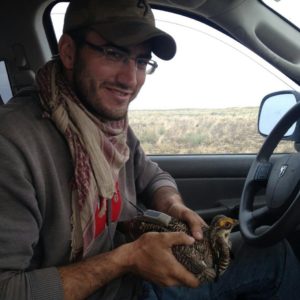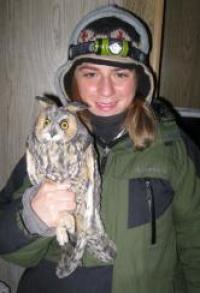The New Mexico Ornithological Society (NMOS) is pleased to announce the recipients of the 2014 NMOS and Ryan Beaulieu Research Grants. Each received $1000 to support their research on New Mexico birds.
NMOS Research Grant
Cody Strong, New Mexico State University – Investigating Lesser Prairie-Chicken (Tympanuchus pallidicinctus) seasonal habitat use, reproduction, and survival to understand patterns of declining lek attendance
In April 2014 the Lesser Prairie-Chicken was listed as Threatened under the U.S. Endangered Species Act. The Lesser Prairie-Chicken was once native to shortgrass and mixed-grass prairies throughout Texas, Oklahoma, Kansas, Colorado, and New Mexico. However, across its range it has declined by 90% from historical levels. The goal of this study is to provide guidance to resource managers to better manage lands to benefit the species. The project will study Lesser Prairie-Chickens on the Sand Ranch Area of Critical Environmental Concern (ACEC) in eastern New Mexico that has been identified as a “stronghold” for the species by the Lesser Prairie-Chicken Interstate Working Group. In spite of this designation, there has been an alarming pattern of lek abandonment and population declines in the area. They will capture and track adult birds, find and monitor nests, measure vegetative structure, invertebrate abundance, humidity and temperature at nests, etc. With these data they will characterize the breeding biology, demographics, movement patterns, and habitat use of this population of Lesser Prairie-Chickens, identify limiting factors to their population, and provide control data for other studies in areas affected by energy development and other management practices. NMOS funds will be used to purchase equipment (e.g., materials for funnel traps) and fuel for field work.
Ryan Beaulieu Research Grant
DeeAnne Meliopoulos, New Mexico State University – Impacts of Solar Energy Development on Breeding Birds of the Nutt Grasslands, NM
Renewable energy development is showing unprecedented growth in the West and concerns about impacts on wildlife have been gaining attention. Although studies of the direct and indirect impacts of wind energy on wildlife and ecosystems have been increasing and producing results, the environmental impacts of solar energy development are largely unexplored. Desert grasslands in southern New Mexico, and the grassland birds that rely on them, are of conservation concern. This is a region with high solar energy potential, and in 2013 the Macho Springs photovoltaic solar power project was initiated in the grasslands between Hatch and Nutt in southwestern New Mexico. This project will survey breeding birds (with a focus on Horned Larks and meadowlark species), find and monitor nests, and record vocalizations, all on plots at varying distances from the solar facility. They will also measure vegetation, invertebrate abundance, and background noise. Results will be used to model bird abundance, diversity, nest survival, nest predation rates, and song characteristics in relation to distance from the solar installation, vegetation characteristics, insect abundance, and background noise levels. NMOS funds will be used to purchase equipment (e.g., sound level meters to record background noise levels).


